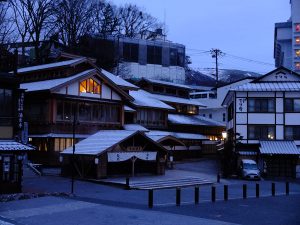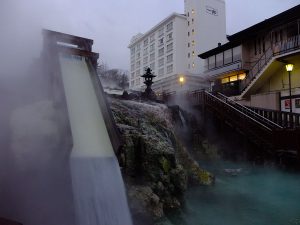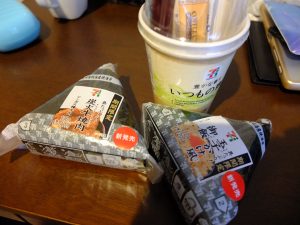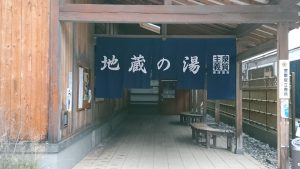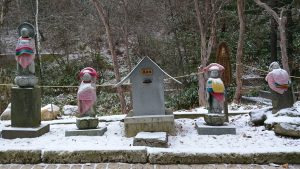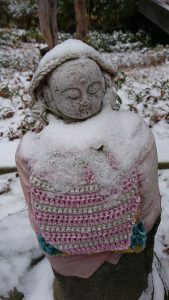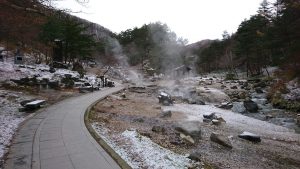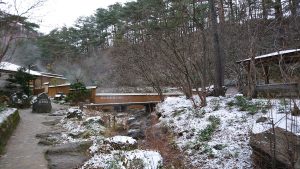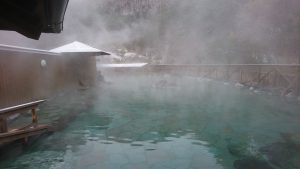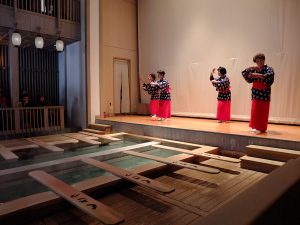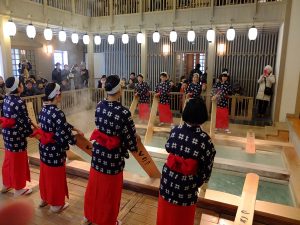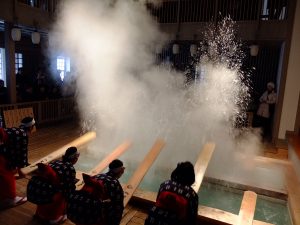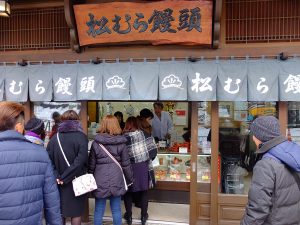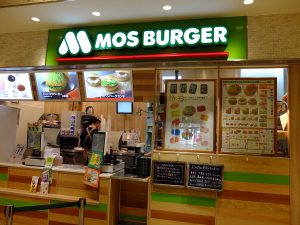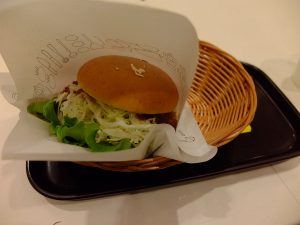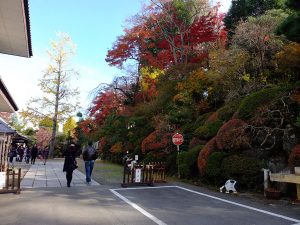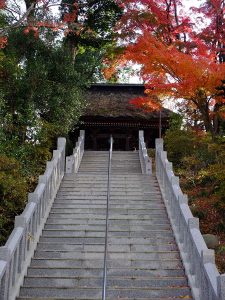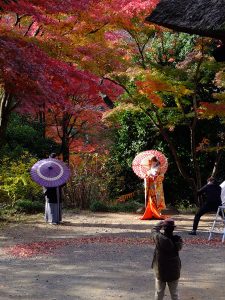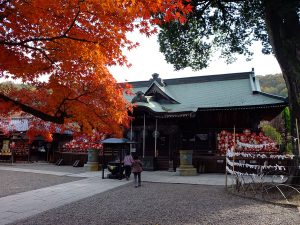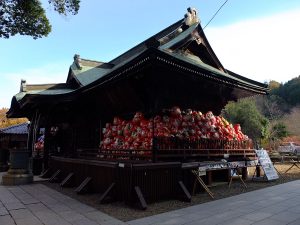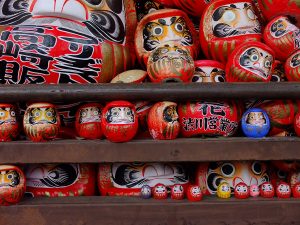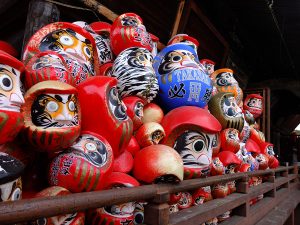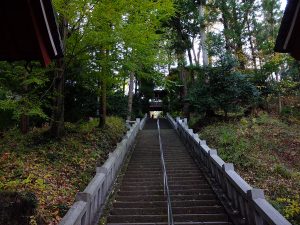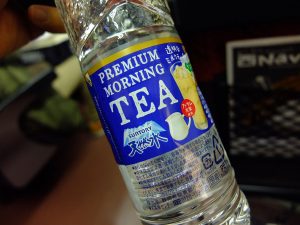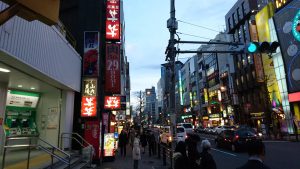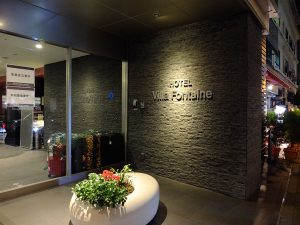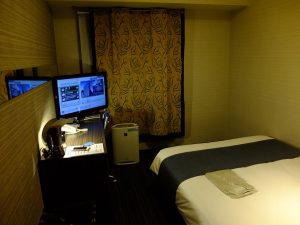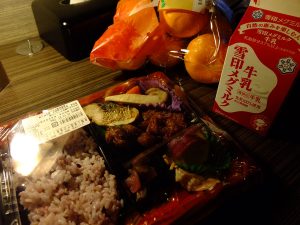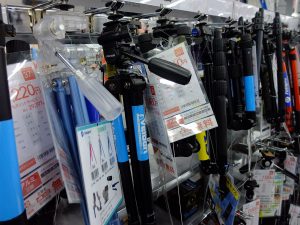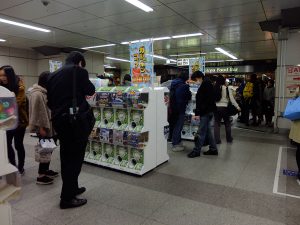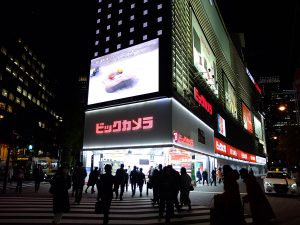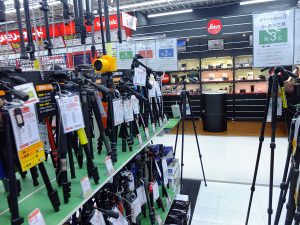Morning. I already ate what bread the hotel provided last night as a late night snack. To find breakfast I went out to the 7-11.
天亮了。我昨晚已經把旅館給的麵包當宵夜吃了。這樣早餐去7-11解決吧。
Snow had fell thick overnight and the roofs and grounds were covered in snow. Not the roads though. Kusatsu ran hot water from their onsen heat exchangers beneath the roads and made them snow proof.
夜間下了場大雪,屋頂和地面上都覆蓋著雪。道路一點積雪也沒有。草津把冷卻溫泉的轉換器排出的熱水導入路面下,成了免費的融雪裝置。
After breakfast I grabbed the towel and handbag and headed to the Sai no Kawara bath. It was too cold for yukata, it’s okay though since Sai no Kawara was a paid bath with changing rooms and supposedly had lockers.
早餐後我拿了毛巾和提袋去西之河原露天溫泉。一大早穿浴衣太冷,西之河原是付費的溫泉似乎有脫衣間和置物櫃可放衣物,應該不用擔心。
The shops were still closed, quiet, except the manju shops filled with activity behind the shut store front, steam rising above them as they steamed manjus in preparation for the day ahead.
店家都還關著,寧睡著,只有饅頭店的門後充滿朝氣,上頭冒出的蒸氣可知他們正忙這蒸饅頭準備開店。
The snow covered Sai no Kawara park was yet another feel different from yesterday and yesterday night. It was frozen and still, the spell broken only by the rising steam. The snow covered Jizou statues wearing hoods and cloaks were a delight out of Japaneses folktales.
雪白的西之河原公園又跟昨天日夜不同一番氣氛。凍結的世界,時間凝結住了,只有上升的熱氣打破這魔法。覆蓋著雪的地藏雕像穿著頭巾和披肩,從日本民間傳說走出來等著善心人。
The Sai no Kawara onsen was famous for its large outdoor bath, since there was plenty of onsen water it could afford to be wasteful. Despite its size its water remained very hot. Above average, not as hot as Shirohata no Yu yesterday. Near the entrance the water was the coolest as the hot water was fed in from about 2 /3 down the length of the bath. There were three other bathers but they soon left, and I had the huge bath to myself. I floated in the water, watching the steam rising all around toward the cloudy skies, losing track of time and self, in that moment the whole universe was contained in that bath. It was a strangely unsettling experience.
西之河原溫泉是有名的超大露天溫泉,也只有這裡溫泉水這麼充沛的地方可以這樣揮霍。盡管池子很大水一樣很熱。比一般的溫泉熱,沒有昨天的白旗之湯熱。由於溫泉注入口是在大約池子2/3長的地方,靠近入口處比較涼。我到時裡頭的另外三個泡湯客過不久就離開了,巨大的池子就被我一個人包場了。我在水中飄浮著,望著四周升向灰色天空的蒸氣,慢慢迷失時間和自我,那一刻全宇宙都容納在溫泉池內。很奇妙,又有點令人不安的感覺。
After the onsen bath the shops were starting to open. The shops here also opened early, no doubt to take advantage of people who stayed overnight who were now looking for souvenirs to take home. Especially the manjus which has to be eaten fresh.
泡完溫泉回程上有些店家已經開了。這裡的店也比較早開,大概是看準住客們離開前要買點特產帶回去。尤其是饅頭需要新鮮著吃。
A small incident happened on the way, I dropped my tripod and something came off. I picked it up and looked it over. The plastic head holding the mount to the pole had completely snapped in two and was unrepairable. A lot of little accidents on this trip so far. This one could be addressed, have to make time to go out and buy a new tripod once I get back to Tokyo.
在逛街時出了點意外,三腳架沒拿好掉地上了,從中摔出了什麼。我撿起看了看。連接腳架和雲台的塑膠頭斷成了兩半,沒辦法修了。這次旅行中似乎有很多小地方出差錯。這個算好解決,回到東京後再買一個新的就行。
I return to the hotel and checked out, leaving my luggage there to be picked up later. There was one last thing to experience in Kusatsu.
我回到旅館退房,把行李留著去搭巴士時拿。在草津還有一件事不可不體驗。
Because Kusatsu’s onsen is so hot, people in ancient time had to wait a long time for it to cool before able to take a bath, so overtime there developed a special tradition of cooling down the water by stirring it with a giant paddle and jikanyu “timed bath”, where one paddles the water to cool it, pour the water on one’s head and then bathes for exactly 3 minutes on the command of a bath leader. Overtime the paddling became a song and dance tradition which is still performed in the Netsu no Yu. For those interested in the full on experience there are baths in Kusatsu that hosts timed baths.
因為草津的溫泉實在太熱了,古時候要等許久等到水溫冷下來後才能泡湯,於是發展出了一種用長木板攪動池水來促進冷卻速度的文化,還有時間湯,聽泡湯指揮的口令一起攪拌冷卻,舀水沖頭,然後跳下去泡三分鐘起來。久而久之用木板攪動溫泉的動作發展成一種湯舞的歌舞文化,現在在熱乃湯內還有表演。若對時間湯有興趣的話草津也有溫泉池提供這種體驗。
The Netsu no Yu puts on about 3 performances each morning and afternoon, the later afternoon sessions become quickly packed as this is one of the first things guests would think of doing after checking in.
熱乃湯差不多早上下午各3場表演,且由於大家入住後都會想要去看,下午的場次很快就會爆滿。
The performance itself is only a few minutes. To create a more complete experience they added more elements to create 4 segments The first is a traditional dance performed on stage, then the yumomi performance, then audiences are invited to try to paddle the water as part of the yumomi themselves, then finally a slightly different yumomi performance that ends with a giant splash of water.
表演本身只有幾分鐘。為了提供一個完整的節目,添加了許多元素組成四個橋段。第一個是在台上表演的傳統舞蹈,然後才是湯舞表演,然後觀眾們可以上去自己試試看攪動木板加入湯舞,最後是另一段不太一樣的湯舞,收尾時用木板濺起高大的水花。
After watching the performances I bought some sweets and manjus to bring home, picked up my luggage and went to the bus terminal to begin the journey back to Tokyo.
看完表演後利用剩餘的時間買了些和果子和饅頭給家人,回頭拿了行李去巴士中心搭車回東京。
The bus was full. Wait what?
巴士客滿了。什麼?
If I couldn’t get on this bus, the next bus was not due for another hour and half.
若這班上不去的話,下一班可要再等一個半小時。
Thankfully the staff explained that they were bringing in another bus and that there was a 30 minute transfer time at Naganohara-Kusatsuguchi, there was no worry about missing the train. Looking around, there were almost 20 people in the waiting area waiting on the second bus.
萬幸,站務人員解釋說他們正調派另一輛巴士,在長野原草津口轉JR有30分鐘的空檔,一定趕得上不用擔心。左右看看,候車室大約有近20人在等第二班車。
I wandered around the bus terminal for abit, checking out the souvenir shop and eatery here. The souvenir shop occupied a small space in one corner of the waiting room. What’s sold here did not defer much from what’s sold in other shops. Mostly sweets and onsen made beauty products. There’s an eatery downstairs, the menu looked like it would be a decent choice for lunch or dinner if one wasn’t picky.
也只能巴士中心晃晃,看看有什麼紀念品店和小吃店了。紀念品店就在候車室的一個小角落,賣的跟其他店差不多,糕點和溫泉美容品。樓下有一家餐館,看菜單若不挑的話吃午餐或晚餐應該很OK。
About 10 minutes later the bus showed up. The driver asked if there were anyone who was not going to Naganohara-Kusatsuguchi station. There were none. So the driver turned the bus into an express and drove directly to the station without stopping instead, arriving only a few minutes later than the previous bus.
第二班巴士大約10分鐘後轉入巴士中心。駕駛問大家有沒有人不是去長野原草津口的。沒有。於是司機便把巴士改成快車,中途不停直接開到車站,只比前一輛車晚幾分鐘到。
The train was once again a local train except this one didn’t go all the way to Takasaki, instead everyone had to transfer at Shin-Maebashi, about 3 stops north out from Takasaki. The transfer was simple and well timed like most Japanese connections, simply walk across the platform to the waiting train.
轉接的電車依然是區間車,不過這般連高崎都沒到,所有人必須在新前橋,大約離高崎還有3站,下車轉另一班車。轉乘跟日本大部分的轉接一樣簡捷,走過月台搭對面等待的車就成了。
The communities along the line likely didn’t have enough patronage to support frequent services, combining tourists going to Kusatsu onto the local trains was a way to increase the number of trains and made life a little more convenient for the locals. Still given the number of people visiting Kusatsu I could not help but think that they could add one or two more express services a day. Currently there were only two express trains on weekdays, both timed to be more convenient for tourists coming to Kusatsu (noon and afternoon for check in at hotels) but not quite as convenient for those leaving (leaving in the afternoon and late afternoon, none if one wanted to leave in the morning).
沿線村落的搭乘人數不足以支撐多的班次,利用去草津的遊客來補足區間車的使用率的確可讓居民的生活更方便。但是看這去草津的遊客數量,不得不認為應該可多加一兩班快車。目前平日只有兩班特急,時間上兩個皆是為了去草津的住宿客設計(中午和下午到配合入住),要離開的旅客就沒那麼方便(下午和黃昏,若要早上離開沒有快車)
By the time I got to Takasaki it was almost 1pm and I was starving.
到高崎時已經快一點,肚子早在餓扁了。
I planned to go the Daruma temple in the afternoon and there was only one train every hour. The next one was at 1:22, I had less than half an hour to toss my luggage into a locker and get lunch. Doesn’t look like I have time to go to that kamameshi (rice in a pot) place.
下午計畫去達摩寺而去的電車一小時只有一班。下一班是1:22,我只有不到半小時把行李箱丟到置物櫃內和解決午餐。看來沒時間去那家釜飯了。
First thing first, I followed the signs to the lockers, downstairs and past a food court. I didn’t have enough changes on me, stupid locker only takes 100Y coins. I looked about for a coin exchanger and noticed there was also a row of lockers that used suica to access. Even better. I chucked my luggages into the locker and swiped my card.
該做的先做,我順著置物櫃指標找去,下樓經過一個美食街。身上的零錢不夠,該死的置物櫃只收100Y硬幣。我左右張望,看哪裡有零錢機,此時發覺另一排置物櫃可用suica。這更好。我把行李塞入置物櫃後拿卡刷下去。
Now, as to the problem of lunch…. I turned to the nearby foodcourt passed a moment ago. There was the same Nagasaki noodle place I had last time in Hakata, a ramen place, some rice don place. Oh, a Mos Burger, perfect.
那麼,午餐怎麼解決呢。我轉回剛經過的美食街。有家上回在博多吃過的長崎麵店,拉麵,丼飯。喔,有Mos Burger,正好。
Unadventurous, quick, not too pricey and easy to take with me if time runs short.
無挑戰性,快速,價錢合理,若時間不夠隨手拿著也方便。
I ordered a seasonal special and found a spot to sit. The food court provided drinking water and paper cups and disposable teatowels to wipe down the tables. Never noticed that on previous trips.
我點了季節限定漢堡,找了個位子坐下。美食街有提供紙杯和飲水機,還有免洗茶巾用來擦桌子。前幾次旅行好像沒有注意到這些。
Daruma temple in Takasaki is said to have been founded several hundred years ago original as a temple of worship of the 11 headed kannon. During a flood a piece of black wood was seen giving off miraculous light and was preserved. An old man later dreamt of Daruma commanding him to carve a figure of him using the black wood. Thus the temple was born. Daruma was a legendary monk who was said to have also started the kungfu tradition at the Shaolin temple. The temple’s full name is Shorinzan Darumaji or Shaolin Mountain Daruma Temple, whether there’s any connection between Shaolin in China and this one is unclear to me.
高崎的達摩寺據說是幾百年前創寺,一開始祭拜的是十一面觀音。後來有次洪水衝來一塊散放祥光的黑色木頭,於是被人留下供奉。後來一名老人夢到達摩旨意他將木頭雕塑為佛像,才成了達摩寺。達摩是一個傳說很多的得道僧人,也據說是少林武學的創始者。高崎達摩寺的全名是少林山達摩寺,至於跟中土少林寺有沒有直接淵源就不清楚了。
There is a tradition involving Daruma dolls, a rounded doll in the image of Daruma. The dolls are created with blank eyes. People who wished for something was to paint the left eye of the doll when making their wish, then complete the other one once their wish become true.
達摩有個特別有關達摩翁祈願的傳統。木偶製作時兩眼是留白的,許願的人許願時將左眼畫上,等如願了再把另一隻眼也畫上。
This is why there are mountains of dolls piled up on either side of the worship hall.
於是佛堂兩旁的達摩翁堆的如山一般高。
The temple is just a short 5 minutes trail ride out from Takasaki. Get off at Gunma-Yawata station then a short 1.5k walk to the temple.
佛寺離高崎5分鐘車程。在群馬八幡站下走1.5公里。
The road went through low density suburb area. On either side were mostly one or two storey houses, except for a strangely located rice shop and what looked to be a car parts factory. Finally cross a busy bridge over a river and one arrives at the foot of the temple.
往佛寺的路經過低密度社區。兩旁大多是一兩樓獨棟屋子,除了一個不知為何在這的米店和一個汽車零件工廠。最後經一個繁忙的橋過河就到佛寺山腳下。
I mistakenly went up via the parking access road on the side. All for the best as the main entrance was a very long flight of steps that would make all who visits bow in respect.
我太早轉結果經停車場道路從側門進入的。不過看正門讓人心生敬意的超長階梯或許這樣的走法比較好。
The autumn leaves were at their peak, the temple halls nested amidst the steep hillside brushed with vibrant orange and red.
正是紅葉最亮麗的時候,一座座佛堂錯落在沾滿紅橙水彩的丘陵邊上。
It was a weekday and there were few people about. There was couple in traditional clothing getting their wedding album taking and two or three others here to pray and see the autumn leaves.
今天是平日,寺院裡沒有什麼人。有一對在拍婚紗的新人,另外兩三個人是來拜佛看紅葉。
There were many dolls presented to the temple, some big, some small. Most were presented by businesses wishing for successes, the biggest ones were over a metre tall.
還願給佛寺的達摩翁也太多了,有小有大。多是企業祈求生意興隆的,最大的有一公尺大。
To one side was a small museum displaying hundreds of different Daruma dolls. On one wall was a map showing how the Daruma dolls differ between areas of Japan. Daruma from Takasaki was the quintessential round squash shaped, some area had ones that were slender, some cylindrical, some more egg shaped. Some were cute, some had a regal expression, others stern and serious.
達摩堂一旁有一個小展示館,擺有數百個不同的達摩翁。一面牆上有張地圖標示日本各地達摩翁不同的樣子。高崎的達摩翁是最熟悉的圓瓜型,有些地區的比較纖細,有的是圓柱型,有的比較像雞蛋。有的表情可愛,有的莊嚴,也有的很嚴肅。
I spent maybe 30 minutes at the temple. There was also only one train an hour back to Takasaki and it would take at least 10 minutes to get back to the station.
我只在佛寺待了30分鐘。回去高崎的班車也是一小時一般,而走回車站就要10分鐘。
After returning to Takasaki I picked up my luggage and hopped on a Shinkansen, this time an E7 train. The trip back to Ueno took 45 minutes and I estimated that I’d get to check in about half past 4pm.
回到高崎,拿出行李去搭新幹線,這次搭到的是E7型列車。到上野要45分鐘,預估四點半入住。
My hotel for the next two day was Villa Fountaine Kudanshita, a strange name since it was closer to Jimbocho station, even the Suidobashi station was closer.
接下來兩天的旅館是Villa Fountaine九段下,名字怪怪的因為離神保町比較近,連水道橋站都近一點。
Coming from the shinkansen I had to first go from Ueno to Akihabara, transfer there onto Suidobashi. If I had known better I might have transferred at Tokyo station since transfering there to the Chuo line then transferring again at Ochanomizu required much less walking and stairs than Ueno and Akihabara despite the same number of transfers.
由於是搭新幹線進市區,要先從上野轉車去秋葉原,然後再轉去水道橋。不過我若對路線比較熟的話就會到東京再搭中央線快速然後在御茶之水轉慢車,這樣月台比較相近,不用像上野秋葉原走那麼多階梯。
The area immediately outside the Suidobashi station was filled with izakayas, restaurants, pachiko and karaokes, before giving way to quieter office areas.
水道橋站外滿是居酒屋,餐廳,小彈珠和卡拉OK,過一段後轉成安靜的辦公區。
Villa Fountaine was in one of those quieter areas, some 500 metres from Suidobashi and another two blocks to go till the busy main street above Jimbocho station.
Villa Fountaine是在這比較安靜的區域,離水道橋500公尺,距離神保町站上熱鬧的大道還要再走兩條街。
Villa Fountaine felt more western (not sure why, just a feeling). Its offerings is supposed to be on the higher side of business hotels and catering to foreigners (it has airport limousine and some of its hotels has shuttle bus running to Tokyo station) and comparatively does have a larger room.
Villa Fountaine感覺比較西式,說不上為什麼。提供的服務理當在商務旅館中比較高級,也偏外國住客(機場接送車有到,有分店有到東京車站的交通車),房間有比較較大。
Something felt amiss however which I could not quite grap. It could be the darker decor or the barebone amenities offered, it didn’t felt as welcoming.
不過有點地方不太對勁。有可能是裝潢比較昏暗,或著是提供的設施有點簡陋,總之沒有很討喜。
By the time I have settled in it was past 5pm. I grabbed a bento from the nearby supermarket and had dinner while browsing for where to buy a new tripod.
整頓好後已過5點。我從附近超市隨便拿了個便當回房邊吃邊研究去哪買新的腳架。
BIC CAMERA at Akihabara was the closest and I decided to check out there instead.
BIC CAMERA秋葉原看來最近,就去那吧。
Not realizing that each BIC CAMERA might stock completely different items. Akihabara turned out to be not the best choice to look for tripods. They had a good selection but all too professional; none of the cheap, small travel tripods I was looking for.
完全沒意識到BIC CAMERA每家擺的東西可能完全不一樣。結果秋葉原可能不是最適合買腳架的地方。不是說沒有選擇,選擇很多,但都太專業沒有我要的便宜輕便的攜帶腳架。
From their websites stock levels I deduced that the shop with the most selection was the Ikebukuro store. It was half an hour to get there. I had actually gotten to Ueno before realizing the Yurakucho one, a station south of Tokyo station, had almost as good a variety and it showed to have the one I wanted in stock. Immediate reverse, hop off the train and onto the one on the other side going the other way.
從網站上的存貨表看來池袋的選擇最多。過去那要半小時。我都做到上野了才發覺有樂町,東京往南一站而以,就有不少選擇,而我看上的那款也顯示有貨。急忙掉頭,下車上對面反方向的車。
The BIC CAMERA is right outside the station, it did not seem bigger than the Akihabara store, just a different focus. Cameras had half of B1 allocated as opposed to the small corner it occupied in Akihabara. Here there was a huge variety of tripods, from travel ones to big, heavy clubbing weapons aimed at professionals. Curiously, some of the funky super compact tripods I saw at Akihabara were nowhere to be found here.
BIC CAMERA就在一出車站對面,看起來沒有比秋葉原的大,只是重心不同。B1有半層樓分給相機部門,不像秋葉原只有一個角落。這裡的選擇就多了,從旅行攜帶型但巨大,可以用來捶人的專業用腳架。有趣的是,在秋葉原看到的超炫摺疊腳架這裡卻沒有。
I bought the tripod I had came here for then decided I might as well wander through the other floors and see what they sold.
我拿了我要的腳架,想想既來之則逛之吧,去其他樓層看看有賣什麼。
I was genuinely surprised when I found they had an entire floor dedicated to cosmetics and pharmaceuticals. The store was catering to Chinese tourists, I realized. Indeed, there were more tax-free counters than there were regular ones.
發現有一整層是藥妝,挺意外的。這家分店很明顯是瞄準中國觀光客的,免稅櫃檯竟然比一般結帳櫃檯多。
In the games section, PS3 games were on clearance for 500 to 1000Y each. I thumbed through them, finding nothing of interest. A shame, would have been a treat if I could get the rest of the Atelier games.
在電玩區PS3的遊戲正在清倉,一片500,1000Y而以。我翻了翻但沒什麼好遊戲。可惜了,若能把鍊金術師系列收集全倒也不錯。
On the way back I went to the chemist store next to Suidobashi station and bought a small tube of handcream. BIC CAMERA sold handcream too but they were big bottles. I had meant to get handcream before going to Kusatsu but the lost jacket that day took away all the time, now my fingers were hurting from exposure to the cold dry air.
回旅館路上我在水道橋站旁的藥店買的一小管護手霜。剛BIC CAMERA有賣但太大罐了。其實去草津前就有打算買的但搞丟外套耗去了時間,現在手被凍的破皮有點痛。
